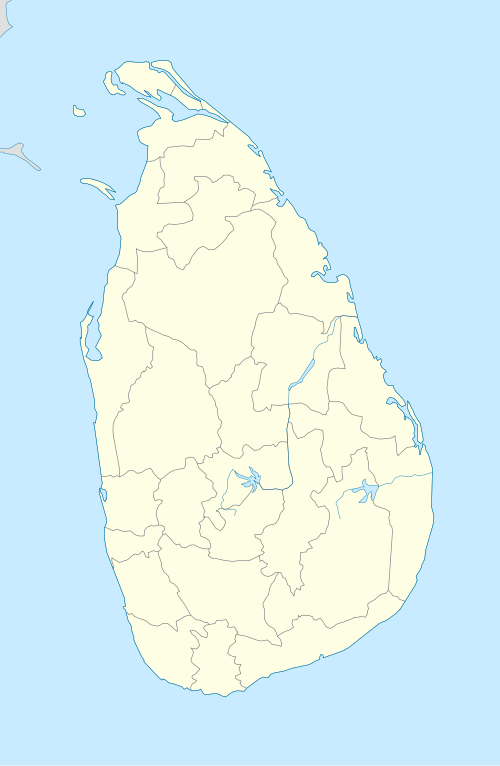Thambiluvil
| Thambiluvil தம்பிலுவில் | |
|---|---|
| Village | |
 Thambiluvil | |
| Coordinates: 7°08′0″N 81°51′0″E / 7.13333°N 81.85000°E | |
| Country | Sri Lanka |
| Province | Eastern |
| District | Ampara |
| DS Division | Thirukkovil |
Thambiluvil (Tamil: தம்பிலுவில்) is a coastal village in the Eastern Province of Sri Lanka. It is 78 Km south of Batticaloa along the east coast. It is bounded by the sea in east and a lagoon named "Periya Kalappu" to west with paddy fields which increase the natural attraction of this village. Thambiluvil is the famous place for the old Tamil culture and traditions of ancient Mattakkalappu Desam.
Etymology
The collection of tales of Batticaloa villages - "Mattakkalappu Purva Sarithiram" mentions that Megavarnan, the son of Chola princess "Thambathi Nallaal" and Kalinga prince "Puvaneya Gajabahu" renovated Thirukkovil Sithira Velayutha Swami Kovil and constructed a small tank in the memory of her mother and named it as "Thambathi-Vil" [1] (literally Pond of Thambathi). It is believed that "Thambathivil" disintegrated to "Thambiluvil" later. A small pond called as "Raman Kulam" east to Thenral Road is identified as Thambathivil now.
Another etymology suggests that Thambiluvil derived from "Thambal+Vil" (தம்பல்+வில்) which means "sludge puddle + Pond" gave the name to this village.[2] Dutch maps of Ceylon and quotes of elders indicate that former Thambiluvil village spread south to Kolavil and north to Thandiyady and it seems to include a vast water source used to Paddy cultivation and the latter etymology also can be considered as suitable one.
History
Thambiluvil village along with its sister village Thirukkovil had significant important in the history of Eastern Tamils. It was part of "Mattakkalappu Desam - Batticaloa Country" (Batticaloa and Ampara Districts nowadays) until the formation of new Ampara District at the southern part of old Batticaloa District on 1961.
According to some old tales, Thambiluvil, Thirukkovil and their suburbs were primitive settlement of Nāga tribes of old Ceylon and was called "Nagarmunai". [3] The administration of well known Thirukkovil Sithira Velayutha Swami Temple also curried out by Thambiluvil inhabitants through the "Kuty" system named as "Pandu Paravani". This tradition is abandoned by degrees in this modern age.
Geography and Census
Thambiluvil village has an area of 5.05 square kilometer and a population of 8937 inhabitants in 2686 families. [4] 99.55% of the population are the followers of Hindu Saivism while the rest are Chrisitians. It is bordered by Thirukkovil village on south and Thampattai village on North. Agriculture, Animal Husbandry and Fisheries are the common industry of the village.
Social Significance
The cultural significance of Thambiluvil village is well described by many anthropologists including Dennis B. McGilvray[5] and Lester Hiatt [6] in their sociological researches.
Thambiluvil was once rich in practicing Nattu Kuttu and Vasanthan Kummi, traditional dances of Batticaloa Tamils which are totally ceased away from that village now cause of ethnic conflict long lasted for last 40 years.
The cult of the goddess Kannaki common in Eastern region can be also observed in this ancient village. Some legends suggest that Kannaki Cult might be spread from this village.[7] Thambiluvil Sri Kannaki amman temple is very much praised by the inhabitants and neighbor villages.
See also
- Thambiluvil Inscription
- Thambiluvil Madhya Maha Vidyalayam
- Thambiluvil Sri Kannaki amman temple
- Thirukkovil Sithira Velayutha Swami Kovil
- Thambiluvil Gayathri Peetham
References
- ↑ F.X.C.Nadaraja, Mattakkalappu Manmiyam, 1998, p.30
- ↑ Vellavur Kopal (2006) "Kizhakkilangai Thamizhakam" p.46
- ↑ Nirmala Rmachandran (2004)"The Hindu Legacy to Sri Lanka" p.103
- ↑ 2009 Census
- ↑ Dennis.B.McGilvray (2008) "Crucible of Conflict"
- ↑ Lester R.Hiatt, “The Pattini Cult of Ceylon : a Tamil Perspective”, “Social Compass”, Vol. 20:2, 1973 June, pp. 231-249
- ↑ http://invokingthegoddess.lk/history/4/
External links
Coordinates: 7°08′N 81°51′E / 7.133°N 81.850°E